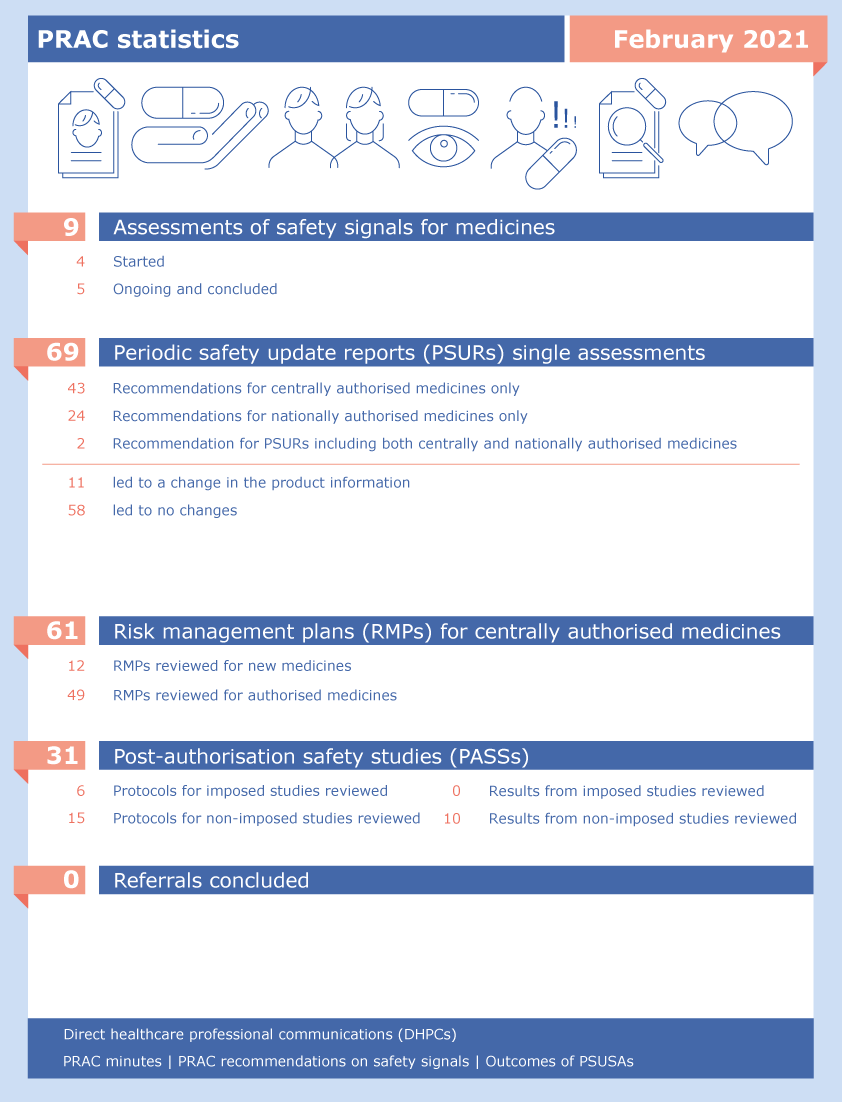Meeting highlights from the Pharmacovigilance Risk Assessment Committee (PRAC) 8-11 February 2021
NewsHumanCOVID-19PharmacovigilanceReferrals
EMA has started a review of obesity medicines that contain amfepramone. These medicines are authorised in some EU countries as treatment for patients with obesity (body mass index of at least 30 kg/m2) in whom other weight-reduction methods have not worked on their own. Amfepramone medicines are authorised to be used for 4 to 6 weeks and no longer than 3 months.
A review by EMA’s safety committee (PRAC) of the recent periodic safety update report (PSUR) for amfepramone raised concerns that require further evaluation. The concerns include heart problems, high blood pressure in the lungs, use of the medicine for longer than 3 months, exceeding the maximum recommended dose, and use during pregnancy despite recommendations against such use.
As a result of these concerns, the Romanian medicines agency requested a review of the safety of amfepramone medicines in the context of the medicines’ benefits. EMA will communicate the PRAC’s recommendations once the review has concluded.
PRAC has concluded its review of a safety signal to assess reports of acute kidney injury (AKI) in patients with COVID-19 treated with Veklury (remdesivir).
The PRAC assessed all available information, including data provided by the marketing authorisation holder, analysis of reported adverse reactions, data from clinical trials and published scientific literature. After taking all the data into consideration, the PRAC concluded that currently there is no evidence indicating that the reported kidney problems are associated with the use of Veklury.
The risk of kidney injury will continue to be carefully monitored in the context of the periodic safety update reports (PSURs) and of the pandemic summary safety reports submitted by the marketing authorisation holder.
Veklury received a conditional marketing authorisation and is indicated for the treatment of COVID-19 in adults and adolescents (12 years or more) with pneumonia who require supplemental oxygen.
As part of the review of the pandemic summary safety reports for Veklury, the PRAC already looked at cardiac adverse events (cases of arrythmia(s), hypotension and shock). Additionally AIFA, the Italian Medicines Agency raised a signal regarding 11 cases of sinus bradycardia (slow heartbeat with a resting heart rate of 60 beats per minute or less) in patients who had received Veklury.
After reviewing the available evidence provided in these cases, the PRAC decided to request an in-depth evaluation of all available data, including reports from Eudravigilance, clinical trials and the published literature.
At this stage, it is not yet clear whether there is a causal association between Veklury and the reports of sinus bradycardia. These reports form a ‘safety signal’ - information on new or changed adverse events that may potentially be associated with a medicine and that warrants further investigation.
Enhanced safety monitoring in the form of pandemic summary safety reports is one of the obligations imposed on the marketing authorisation holder in the context of the conditional marketing authorisation for Veklury. The company is required to submit pandemic summary safety reports to EMA on a regular basis. These reports are reviewed by the PRAC and any areas of concerns further investigated, if needed.
As part of its advice on safety-related aspects to other EMA committees, the PRAC discussed direct healthcare professional communications (DHPCs) containing important safety information for Strimvelis, Venclyxto and Zolgensma.
The DHPC is intended to warn doctors of the risk that the use of the gene therapy Strimvelis could lead to genetic mutations with the potential to cause cancer in patients who receive this medicine. Strimvelis is a medicine to treat severe combined immunodeficiency due to adenosine deaminase deficiency (ADA-SCID). This is a rare inherited condition in which there is a change in the gene needed to make an enzyme called adenosine deaminase (ADA) that is crucial in maintaining healthy white blood cells. Doctors are advised to monitor patients long-term for cancerous changes with at least annual visits for the first eleven years and then at 13- and 15-years post treatment with Strimvelis.
PRAC has recommended this DHPC in the context of a careful analysis of a single case of acute leukaemia (lymphoid T cell leukaemia) reported in a patient who was treated with Strimvelis in 2016, almost 5 years prior to the cancer diagnosis.
The DHPC intends to inform healthcare professionals on new recommendations and measures for the mitigation of the risk of tumour lysis syndrome (a serious complication with rapid break down of cancer cells) in patients treated with Venclyxto (venetoclax), and the related updates to the summary of product characteristics (SmPC).
The DHPC is intended to warn doctors of the risk of thrombotic microangiopathy (an acute and life-threatening condition characterised by thrombocytopenia, haemolytic anaemia and acute kidney injury) following administration of Zolgensma (onasemnogene abeparvovec), a gene therapy for patients with spinal muscular atrophy. The DHPC enhances awareness of this risk and advises on the need for prompt clinical management.
The DHPCs for the gene therapies Strimvelis and Zolgensma will now be sent to the Committee for Advanced Therapies (CAT), EMA’s expert committee on advanced therapies, and then to EMA’s human medicines committee (CHMP) for a final opinion. The DHPC for Venclyxto will go directly to the CHMP. Following the CHMP decision, the DHPCs will be disseminated to healthcare professionals by the marketing authorisation holder, according to agreed communication plans, and published on EMA’s website and in National registers in EU Member States.

Glossary:
|
Procedure |
Status |
Update |
|---|---|---|
| Article-31 referral: Ifosfamide solutions | Under evaluation | PRAC continued its assessment. |